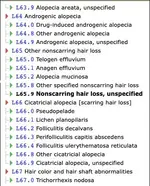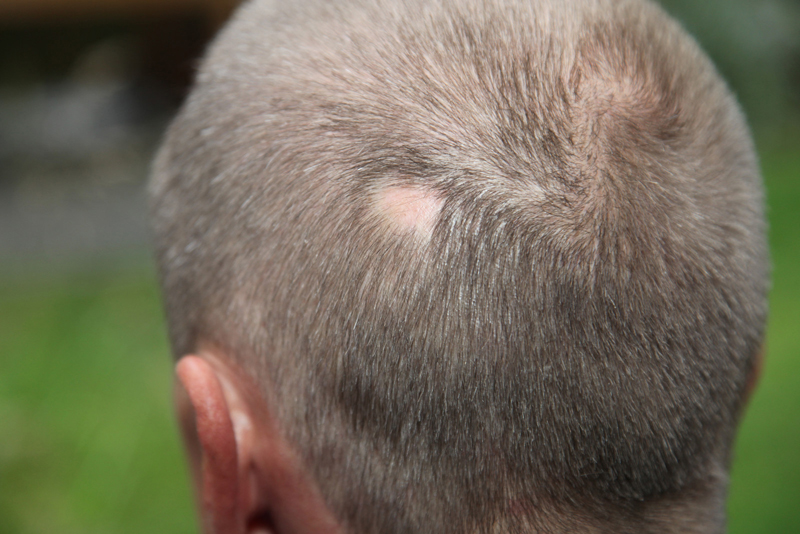No treatments are currently approved by the FDA for this disease.
Payers tend to consider the treatments as merely “cosmetic”, rather than medically necessary, and use this description to deny claims.
Let's look at the codes & coding advice.
What is alopecia?
Alopecia refers generally to hair loss in parts of the body that usually have hair.
There are generally three types:
“Alopecia areata is an unpredictable disease. In some people, hair grows back but falls out again later. In others, hair grows back and remains. Each case is unique.”
For other people, however, hair loss does not stem from autoimmune issues. Plenty of factors can play a role, including hairstyles that pull tightly, stress and damaging hair treatments. Nutritional deficiencies can cause alopecia, as can hormonal changes or even stressful life events.
In many cases, it is not clear to a person experiencing alopecia — or their health care provider — why hair loss has occurred. Pinkett Smith, for example, has said medical tests have been unable to reveal the cause of her hair loss, suggesting she likely does not have the autoimmune version of the condition. She has said she believes it may be related to stress.
Symptoms
Commonly, alopecia areata causes:
Other symptoms may include:


 www.huffpost.com
www.huffpost.com
Tips on getting reimbursement for alopecia areata:

 www.outsourcestrategies.com
www.outsourcestrategies.com
Payers tend to consider the treatments as merely “cosmetic”, rather than medically necessary, and use this description to deny claims.
Let's look at the codes & coding advice.
What is alopecia?
Alopecia refers generally to hair loss in parts of the body that usually have hair.
There are generally three types:
- Alopecia totalis: When a person loses all hair on the scalp.
- Alopecia universalis: When a person loses all hair on their body, which is very rare.
- Alopecia areata: When a person develops patchy baldness somewhere on their body, including the scalp, beard area, eyebrows, eyelashes, armpits, inside the nose, or ears. Alopecia areata is an autoimmune disease (more on that below).
WHAT CAUSES ALOPECIA?
It depends! Alopecia areata is an autoimmune condition, in which a person’s immune system attacks their hair follices leading to anything from a few quarter-sized patches to much greater baldness. It’s not totally clear what causes the immune system to act that way, but experts think it’s probably a combination of genetic & non-genetic factors.“Alopecia areata is an unpredictable disease. In some people, hair grows back but falls out again later. In others, hair grows back and remains. Each case is unique.”
For other people, however, hair loss does not stem from autoimmune issues. Plenty of factors can play a role, including hairstyles that pull tightly, stress and damaging hair treatments. Nutritional deficiencies can cause alopecia, as can hormonal changes or even stressful life events.
In many cases, it is not clear to a person experiencing alopecia — or their health care provider — why hair loss has occurred. Pinkett Smith, for example, has said medical tests have been unable to reveal the cause of her hair loss, suggesting she likely does not have the autoimmune version of the condition. She has said she believes it may be related to stress.
Symptoms
Commonly, alopecia areata causes:
- Small round or oval patches of baldness on the scalp
- Area of bald skin looks smooth and normal
Other symptoms may include:
- Mild itching, tingling, and tenderness in the affected area
- A burning sensation in the affected area
- Abnormalities in the surface of the fingernails (tiny pits or dents, grooves, superficial splitting, or an abnormal area of redness).
- L63: Alopecia areata
- L63.0: Alopecia (capitis) totalis
- L63.1: Alopecia universalis
- L63.2: Ophiasis
- L63.8: Other alopecia areata
- L63.9: Alopecia areata, unspecified


Alopecia Shouldn't Be A Punchline, But It Should Get More Attention
People are talking about the condition after an Oscars ceremony joke about Jada Pinkett Smith's hair. Here's what everyone should keep in mind.
Tips on getting reimbursement for alopecia areata:
- Knowing the patient’s insurance policy and what it covers
- Knowing how the policy deals with a specific treatment
- Knowing whether prior authorization is needed for a therapy
- Submitting accurate clinical documentation – the necessary documentation should be submitted showing that the case meets the insurance provider’s guidelines and meets medical necessity requirements
- Appeal denials: The most common reason for claim denials is because the payer designates a therapy as cosmetic, not medically necessary, and/or being experimental or investigational in alopecia areata and prescribed as off-label use. As about 40% of appeals are successful, so NAAF urges appealing a denial at every level.

Reporting and Documenting Alopecia Areata using ICD -10 Codes
Affecting 6.8 million people in the US, Alopecia areata is a common autoimmune disorder that usually results in unpredictable hair loss in patches.
 www.outsourcestrategies.com
www.outsourcestrategies.com


